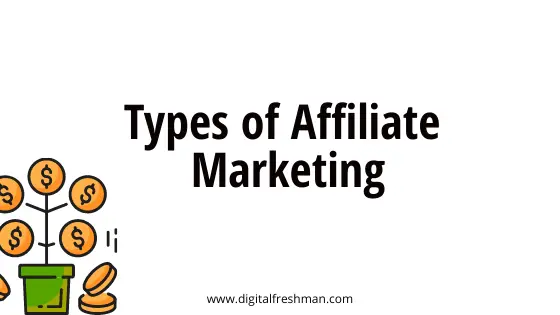Affiliates earn money in many ways that have been put into categories. These categories help to differentiate our levels of association with the products we may be an affiliate for. This article will explain the types of affiliate marketing with examples in detail. We will also talk about how to start affiliate marketing with no money. Essentially there are 3 types of affiliate marketing. The main aim is to help you to decide which route to take when deciding to start affiliate marketing.
What is Affiliate Marketing?

Affiliate marketing is a type of internet marketing where you earn commissions by promoting someone else’s products. The affiliate marketer typically advertises the merchant’s product online in banners or text links. They may also send traffic to the merchant’s website through channels like email marketing, search engine optimization, and social media marketing. Affiliate marketers are paid a commission each time someone clicks on their link and then makes a purchase. The commission can be as little as 1% or as high as 50%.
Affiliates collaborate with individuals or businesses, promoting their products and /or services. Both affiliate marketers and brands profit from it. You will earn a commission for every customer who makes a purchase based on your recommendation. Hence, the more traffic or customers you refer, the more money you’ll make.
According to statistics, the amount spent on affiliate marketing in the US rose from $5.4 billion in 2017 to $8.2 billion in 2022. This demonstrates that affiliate marketing is lucrative and yet available to people who have an interest in starting. This shows how fast-growing the industry of affiliate marketing is.
The main agenda of this article is to guide you through the most effective types of affiliate marketing. I will explain the 3 primary types of affiliate marketing and how to start. These categories show how we relate to the goods we might promote as affiliates.
Types of Affiliate Marketing.
It’s difficult to ascertain whether an affiliate marketer has actually tried the product they are endorsing or not. This is because most of them only have an interest in making money. Sometimes it may not matter to the customer one way or the other.
In 2009, a well-known affiliate marketer Pat Flynn categorized affiliate marketing into three main categories. These are unattached affiliate marketing, related affiliate marketing, and involved affiliate marketing and they will be explained in detail below.
1. Unattached Affiliate Marketing
In the unattached business model, affiliate marketers lack expertise and authority in the niche of the product they’re marketing. Additionally, they’ve no permission to make any representations regarding the usage of the product. In a nutshell, there is no connection between the affiliate marketer and the product or service they are promoting.
Generally, unattached affiliates run PPC (pay-per-click) marketing campaigns. As an affiliate, all you do is put an affiliate link via Google AdWords, Facebook ads, etc. Your hope is that customers will click on your link, buy the product, and in return you earn a commission.
Why choose Unattached Affiliate Marketing?
This type of affiliate marketing is attractive to many affiliates because it requires no commitment. Mostly, it is the only option available to many. Clearly, this type is the best choice for people whose only goal is to make money. Normally, such people will not be considering building a brand or a customer base.
However, establishing trust and a reputation online takes effort. Generally, people are too afraid to commit to working on a blog or website. Some just don’t have the time, and for some, this is the only option available to them.
So, how do you know that you have succeeded in unattached affiliate marketing?
When PPC affiliate marketing works for you in a way that inspires confidence in your audience, you’ve succeeded. When you get to that point, put in a lot of effort to uphold the standards for continued success. Affiliate marketing is a lot more difficult than it sounds. When you have reached that stage, work hard to maintain the standards for continued success. With PPC advertising campaigns you will be able to notice the patterns that working and those that are failing. It is advisable to employ the rinse-and-repeat approach for campaigns that were successful.
Unpopular opinion.
According to well-known affiliate marketer Pat Flynn, unattached affiliate marketing is an income-generating strategy, not a business model. With this in mind, it’s impossible to develop relationships with end users, thus PPC turns you into a virtual middleman. With this paradigm, there is pressure to prioritize prospective revenue over the clients you are serving. Therefore, the dark side of affiliate marketing here is, it prioritizes potential income over the clients you are serving.
2. Related Affiliate Marketing
This is another affiliate marketing strategy that requires some sort of online presence. This type is a mixture of the other 2 types of affiliate marketing explained herein. You can be active through social media, a blog, a podcast, or videos. Additionally, you will have affiliate links to products in your niche, products you don’t actually use.
Every single “earn money online” website included a 125 by 125-pixel advertisement for Text Link Ads when they were popular. In this old advertising model, advertisers could pay to have certain terms on your website linked to their items. This was big in the blogosphere. On their own websites, the majority of these sites didn’t actually employ the text link ad service. You can find a wide variety of affiliate adverts for financial institutions. These include ING, Everbank, Lending Club, and many others on a number of personal finance blogs.
Probably, not everyone who includes one of those links on their blog actually uses all the products and services listed. And it’s okay that way. Including affiliate links that are relevant to your niche on your website is a good way to generate extra revenue. Because you have a website and some authority, people will believe you. They will also trust your choice to place the advertisement on your site. It doesn’t matter whether it’s in the sidebar as a banner or as a text link under your blog post.
Examples
Pat Flynn in his early days in Affiliate marketing used to have a few of these links strewn over SPI. He used to have a number of iPhone applications that used to generate money for him on a regular basis. However, he didn’t actually use the product he was linking to. Flynn personally knew the owner, that’s why he trusted him and decided to put that ad there at the time.
Another illustration is recommending a clothing line or fitness gear that you have never used before. A fashion or fitness blog or YouTube channel, however, can help you attract an audience. This type gives you authority because it enables you to have some influence in the niche and a loyal following. In this situation, you would be regarded as a related affiliate marketer.
The advantage of this type of affiliate marketing is that the affiliate has the knowledge to drive traffic. However, if they haven’t used the product or service, they run the danger of promoting a subpar product or service. This may potentially cost the audience’s confidence in them.
Nowadays, it is a good idea to advertise the correct products or products you are familiar with. Otherwise, you risk losing the trust you have built with your audience. Building authority and trust require hard work, and a subpar affiliate offer might possibly ruin all of that. Therefore, be sure you have faith in the team developing the product you’re recommending and their ability to look after your customers.
3. Involved Affiliate Marketing.
With this type, affiliate marketers draw on their involvement and personal experiences with the product in their marketing efforts. As a result, customers will find the products more attractive, and they will regard you as a trustworthy source of information. However, there is a certain level of responsibility that you need to uphold while making these kinds of recommendations. This is more applicable if you have considerable power and influence on your followers.
Instead, you are speaking directly to those who are paying attention to you and may need the product that you are offering. Unlike PPC, which involves utilizing your money to create money, this doesn’t do that. It involves using your authority, trustworthiness, and reputation. The purpose is to persuade others to follow your advice, put it to use, and then pay you a commission. Naturally, this type of affiliate marketing requires more effort and time to establish trust. If done correctly, it’s likely to yield greater payoffs in the long run.
These affiliate relationships are based on sincerity and trust. The same is true for how we ought to interact with our audiences. From the 3 types of affiliate marketing above, it is important that you choose your best, before starting.
HOW TO START AFFILIATE MARKETING

Even though we have different types of affiliate marketing, the initial stages of starting are the same.
The first step is choosing a niche and identifying the platform you’ll utilize to advertise your goods and services. Also, you need to create a website. In order to effectively advertise and promote, you can try blog channels. Blogs enable you to express your opinion regarding the offer. Companies such as Systeme and Getresponse can allow you to use a free blog on their websites.
After deciding on a platform and creating your website, pick a category you have an interest in or are comfortable with. Having a narrow focus makes it easier to draw in a loyal customer base. Based on your requirements and target market, research affiliate programs and select one or more. Also, consider whether your decision will increase traffic or help you make huge commissions. Finally, provide quality and engaging content centered on the services and seek to increase traffic to your website.
There are various methods that you can use to generate traffic to your website. These include creating an SEO strategy, Email marketing, being active on social media, and writing guest posts.
CAN YOU START WITHOUT MONEY?

Yes! Without any money, you can start affiliate marketing. Numerous affiliate networks and free platforms are accessible for little to no cost. Instead, you need to employ strategies like blogging, social media posting, etc to build a sizable and devoted online following. You can market services like Ezoic, Contabo, Namecheap, and Fiverr without incurring any cost.
Conclusion.
To conclude, you may choose which type of affiliate marketing—Unattached, Related, or Involved—works best for you. But, the ideal course of action is to leverage your authority and presence in a niche. The reason is to advocate things that you’ve used and have helped you in some manner. Think about genuineness and trust. Prioritize service over profit. Consider what will benefit your audience most.
Starting an affiliate marketing business also demands a significant commitment of time and effort. Success in affiliate marketing takes time, as you should be aware. It could take some time after you begin before you begin to generate income. The most crucial stage is to begin as long as you are knowledgeable and prepared.
You’ll succeed with your affiliate income if you participate as much as possible in the affiliate marketing process. Read SPI’s Epic Guide to Affiliate Marketing, Hosting tutorials, and my article on affiliate marketing to understand affiliate marketing. This will help you to know more about affiliate marketing and how it functions. You will also know the ideal ways to integrate it into your business plan.

